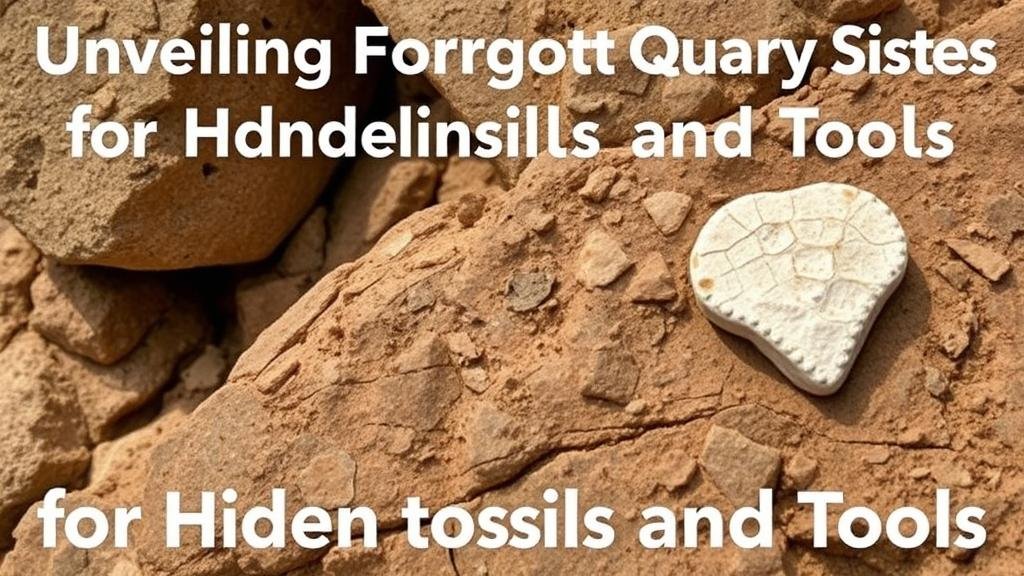Unveiling Forgotten Quarry Sites for Hidden Fossils and Tools
Unveiling Forgotten Quarry Sites for Hidden Fossils and Tools
The exploration of forgotten quarry sites offers significant insights into not only geological formations but also the paleontological and archaeological records encapsulated within. This article aims to shed light on the importance of these sites, particularly in the context of fossil discoveries and the tools utilized by ancient civilizations. With an increasing interest in sustainable excavation practices, the reclamation and study of such quarries stand to augment our understanding of historical biodiversity and human advancement.
The Significance of Quarry Sites in Paleontological Research
Quarries have long been sources of stone, gravel, and other geological materials essential for construction and industrial purposes. But, many of these sites are overlooked as potential repositories of fossils and ancient artifacts. Research indicates that abandoned quarries often present unique sedimentary layers that preserve fossils, providing critical data on prehistoric life. For example, the Upper Jurassic limestone quarries in Solnhofen, Germany, where the famous Archaeopteryx fossil was discovered, exemplify how these locations can yield invaluable paleontological finds.
Quarry sites not only harbor the remains of ancient organisms but also tools and artifacts left behind by early humans. For example, the limestone quarries near Bath, England, have uncovered stone tools and remnants of residential structures that date back to the Mesolithic period (approximately 10,000-5,000 BC). Such discoveries highlight the role of quarries as sites of human activity, revealing the interaction between early civilizations and their environment.
Case Studies
Several notable case studies illustrate the potential of forgotten quarries in unearthing hidden fossils and tools:
- Beidelman Quarry, New York: This site has yielded a wide range of Devonian fossils, including fish and invertebrates, providing insights into the ecosystem of the period.
- Maryland Slate Quarries: The site contains an array of prehistoric tools made from slate, indicating human activity over 8,000 years ago.
- Meadowcroft Rockshelter, Pennsylvania: While not a quarry in the traditional sense, this archaeological site has resulted in the discovery of artifacts dating back 16,000 years, illustrating the continuity of human occupation and ingenuity.
The Methodology of Quarry Research
To effectively unveil these hidden treasures, a multi-disciplinary approach is often employed in quarry research. Geologists, paleontologists, and archaeologists collaborate to analyze sediment layers and their lithological characteristics. Ground-penetrating radar (GPR) technology is increasingly used for non-invasive exploration, allowing researchers to visualize subsurface structures and stratigraphy without extensive excavation.
Challenges and Ethical Considerations
While the potential for discovery is significant, several challenges are associated with the excavation and study of forgotten quarry sites. Legal ownership and land usage rights can complicate research efforts. Also, ethical considerations regarding the excavation of archaeological sites must be addressed, ensuring that proper methodologies are followed to preserve cultural heritage. As noted in a 2021 review published in the Journal of Archaeological Science, “the dissemination of knowledge about historical and archaeological sites must be handled sensitively to maintain site integrity and community relations.â€
Future Directions in Quarry Research
The future of quarry research is promising, particularly with advancements in technology such as 3D modeling and augmented reality applications for virtual site exploration. These tools can help researchers analyze artifacts and fossils in unprecedented detail without further disturbing the sites. Plus, the collaboration between academic institutions and commercial quarry operations can foster a more sustainable approach, where fossil and material recovery can occur without substantial environmental degradation.
Conclusion
To wrap up, the unearthing of forgotten quarry sites represents a dual opportunity: to recover lost fossils that illuminate our planets biological past and to find tools that reveal the behaviors of early humans. By adopting a collaborative, ethical, and technology-driven research framework, we can ensure that these invaluable resources contribute to our understanding of historical ecosystems and cultures. The uncovering of these hidden treasures serves not only to enrich our academic discourse but also to inform contemporary practices related to excavation and sustainability.
Future research in this domain should focus on employing innovative techniques and fostering partnerships to ensure that the neglected wealth of our geological and cultural history can be fully realized for future generations.



